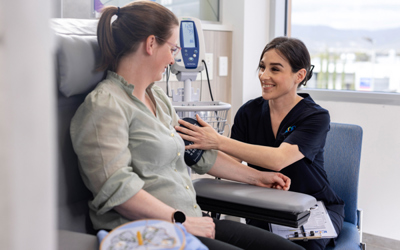Quick facts about soft tissue sarcoma
Soft tissue sarcoma can occur anywhere in the body from soft tissues such as muscle, fat, cartilage, nerves, tendons, lining of joints, lymph vessels or blood vessels. It is most commonly found in the thigh, shoulder, retroperitoneum (back of abdomen) and pelvis
There are more than 70 types of soft tissue sarcoma
Soft tissue sarcoma is a rare type of cancer. It was estimated that in 2021, Australians had a 1 in 149 (0.67%) chance of being diagnosed with sarcoma by the age of 85
Soft tissue sarcoma accounted for 1.3% of all Australian cancer diagnoses in 2021
Types of soft tissue sarcoma
There are more than 50 types of soft tissue sarcomas. Common types include:
-
Undifferentiated pleomorphic sarcoma (UPS)
Previously referred to as malignant fibrous histiocytoma, UPS is an aggressive type of soft tissue sarcoma, usually occurring in the arms, legs or abdomen.
-
Leiomyosarcoma
This is one of the most common types of soft tissue sarcoma and is a smooth muscle tumour. They are most commonly found in the uterus in women but can also occur in bladder or stomach.
-
Liposarcoma
Found in fatty tissue, liposarcomas can develop anywhere in the body but are most commonly found in the retroperitoneum and the thighs. There are many subtypes of liposarcomas including well differentiated, dedifferentiated, myxoid and pleomorphic.
-
Fibrosarcoma
A type of tumour that grows in fibrous tissue, most commonly in extremities, chest, abdomen, head or neck.
-
Rhabdomyosarcoma
This type of soft tissue sarcoma is found in the skeletal muscle cells and can develop anywhere in the body. This is the most common soft tissue sarcoma in children.
-
Synovial sarcoma
Synovial sarcomas refer to soft tissue sarcomas with unknown origins. They are most commonly detected in knee or ankle joints but may also be found in other joints throughout the body including the hips or shoulders.
-
Gastrointestinal stromal tumour (GIST)
A common type of soft tissue sarcoma that originates from the digestive tract, commonly in the stomach.
-
Malignant peripheral nerve sheath tumour (MPNST)
A soft tissue tumour that originates from the lining of the nerve cells. This can occur anywhere in the body but commonly in the arms, legs and trunk.
Signs and symptoms of soft tissue sarcoma
As signs and symptoms for soft tissue sarcoma may be similar to other conditions in some cases, it’s important to see your GP or healthcare professional if you experience any of the symptoms below. Discussing anything concerning as soon as possible can help give you peace of mind and offer the best chance of successful treatment if you receive a soft tissue sarcoma diagnosis.
Soft tissue sarcoma can be difficult to detect as they may not cause any symptoms at early stages. The type of symptoms you experience will also depend on which part of the body the sarcoma develops in.
These may include:

Growing lump under the skin, which may be painless or painful if it is pressing on surrounding muscles or nerves

Trouble breathing

Pain
Stages of soft tissue sarcoma
The TNM system is used to stage soft tissue sarcoma and define what your cancer looks like. The TNM stands for:
Tumour (T) – Describes the size of the tumour and the degree to which it has affected surrounding tissue. The tumour can be graded as T1 (describing a tumour 5 cm or less), T2 (greater than 5 cm but less than 10 cm), T3 (greater than 10 cm but less than 15 cm) or T4 (greater than 15 cm).
Nodes (N) – Describes whether the tumour has spread to nearby lymph nodes. Nodes can be graded from N0, where there has been no spread, through to N1, where the cancer has spread the lymph nodes.
Metastasis (M) – Describes whether the cancer has spread to other areas of the body. Metastasis can be graded from M0, where there has been no spread through to M1, where the cancer has spread to other organs of the body and produced additional tumours.
Soft tissue sarcomas are also given a grade (G) from G1 to G3. Soft tissue sarcomas with a higher grade are more aggressive and have a higher likelihood of growing and spreading compared to those with a lower grade.
The TNM information, along with the grade, helps determine the stage of your soft tissue sarcoma using the guidelines below.
Staging of soft tissue sarcoma in the arms, legs and trunk
-
Stage IA
The tumour is 5 cm or smaller and is low grade.
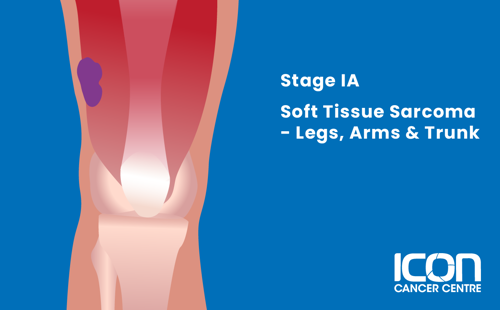
-
Stage IB
The tumour has grown larger than 5 cm and is low grade.
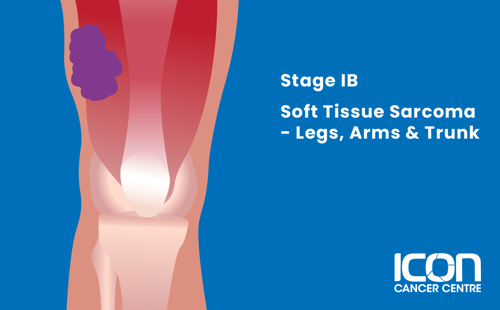
-
Stage II
The tumour is 5 cm or smaller and is mid or high grade.
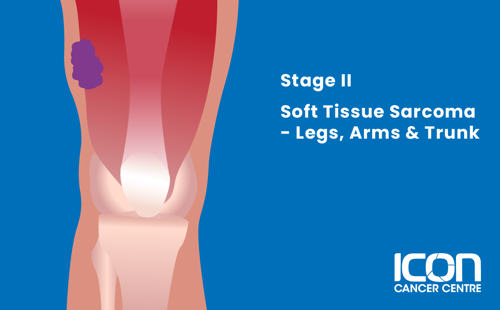
-
Stage IIIA
The tumour is between 5 cm to 10 cm and is mid or high grade.
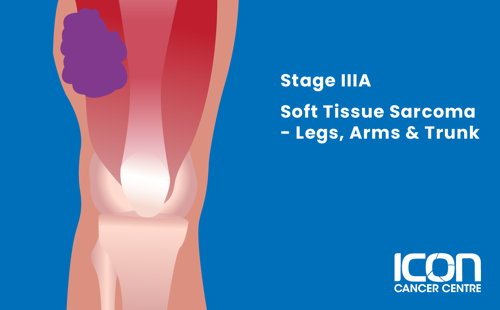
-
Stage IIIB
The tumour is larger than 10 cm and is mid or high grade.
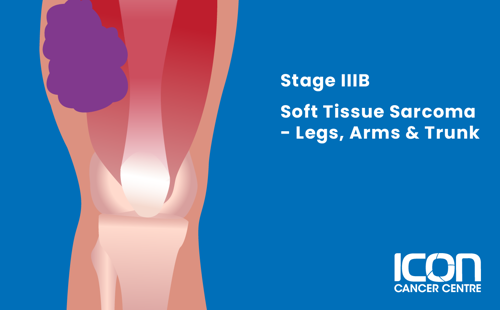
-
Stage IV
The tumour may be any size or grade that has spread to the nodes and/or other parts of the body.
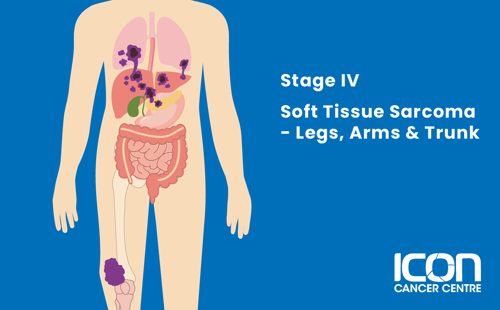
Staging of soft tissue sarcoma in the retroperitoneum
-
Stage IA
The tumour is 5 cm or smaller and is low grade.

-
Stage IB
The tumour has grown larger than 5 cm and is low grade.
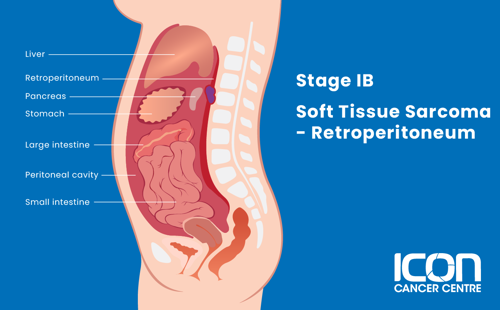
-
Stage II
The tumour is 5 cm or smaller and is mid or high grade.
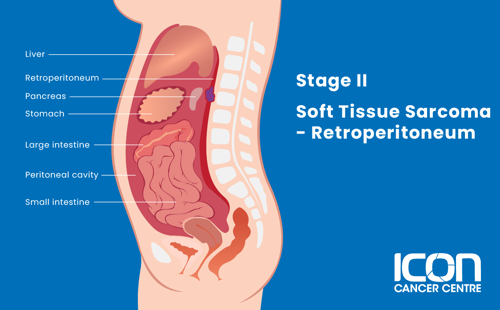
-
Stage IIIA
The tumour is between 5 cm to 10 cm and is mid or high grade.
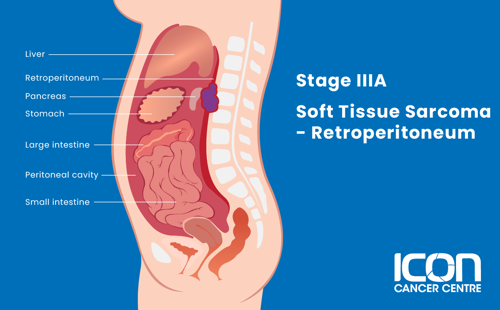
-
Stage IIIB
The tumour is larger than 10 cm and is mid or high grade and may or may not have spread to the nearby lymph nodes.
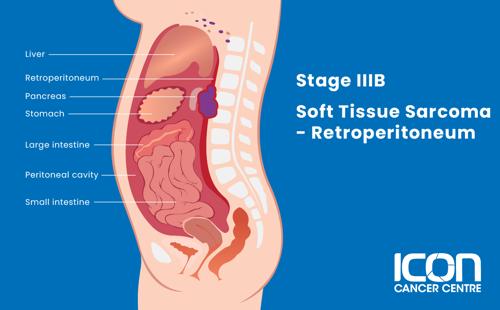
-
Stage IV
The tumour may be any size and may or may not have spread to the lymph nodes, however it has spread to other parts of the body.

Treatment for soft tissue sarcoma
There are many different types of treatment for soft tissue sarcoma. Your treatment will depend on you and your cancer.



